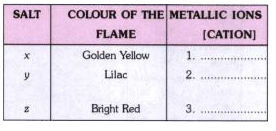A chemistry student trying to detect the metallic ion in a salt, makes a paste on a clean platinum wire loop of the salt with concentrated HCl. When he takes a small amount of this paste and keeps it in a non-luminous Bunsen flame, the colour of the flame changes to grassy green.He should, therefore, conclude that the metal is
Barium
Calcium
Potassium
Strontium
The correct Answer is:A
To determine the metallic ion in the salt based on the flame test described, we can follow these steps:
1. Understanding the Flame Test: The flame test is a qualitative analysis technique used to identify the presence of certain metal ions based on the color they emit when heated in a flame.
2. Preparation of the Sample: The student prepares a paste of the salt with concentrated hydrochloric acid (HCl) on a clean platinum wire loop. This step ensures that any contaminants are removed, allowing for an accurate test.
3. Conducting the Flame Test: The platinum wire loop, now coated with the paste, is introduced into a non-luminous Bunsen flame. The flame should be non-luminous to avoid interference from soot and other contaminants.
4. Observation of Flame Color: The student observes that the color of the flame changes to grassy green. This observation is crucial as different metal ions produce characteristic flame colors.
5. Identifying the Metal Ion: Based on known results from flame tests:
- Barium produces a grassy green flame.
- Calcium produces an orange-red flame.
- Potassium produces a pink flame.
- Strontium produces a red flame.
6. Conclusion: Since the observed flame color is grassy green, the student concludes that the metallic ion in the salt is Barium (A).
Final Answer:
The metal is Barium (A).
---
- Barium produces a grassy green flame.
- Calcium produces an orange-red flame.
- Potassium produces a pink flame.
- Strontium produces a red flame.
The metal is Barium (A).
Similar Questions
The metallic ions (the cations) can be identify by performing flame test which is describe below.
"Make a paste of the given salt in concentrated hydrochloric acid. Load the paste on a clean platinum wire and introduce it in a non-luminous bunsen burner flame. Note the colour of the flame imparted by the flame. Tabulate your answer in the formate given below. The salt x imparts golden yellow flame. The salt y imparts lilac flame and the salt z imparts bright red flame.

View SolutionBorax Bead Test is carried out when the original mixture is coloured. It is done with the help of a cleam platinum wire on which a small loop is made at the end. When borax is heated on platinum wire loop transparent glass like bead is obtained. The hot bead is brought in contact with salt till it reacts with fused borax and colour is imparted to the bead. bead colour is noted.
Colour of the beadIon1. Blue greenCu2+2. Yellow Fe3+3. GreenCr3+4. VioletMn2+5. Dark blueCo2+6. BrownNi2+
Q. The flame used in Borax Bead Test is:
View SolutionBorax [Na2B4O7.10H2O] when heated on platinum loop it gives a dark transparent glass like bead. The hot bead is dipped in the salt till it reacts with transition metal oxide. It produces characteristic bead of meta borate.
Colour of the bead lon(a) Blue green or light blueCu+2(b) YellowFe+2orFe+3(c) GreenCr+3(d) VioletMn+2(e) Dark blueCo+2(f) BrownNi+2
The flame used in Borax Bead test is
View Solution